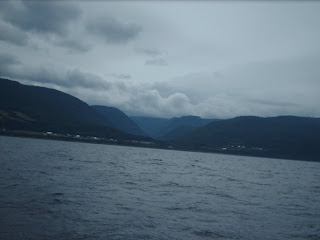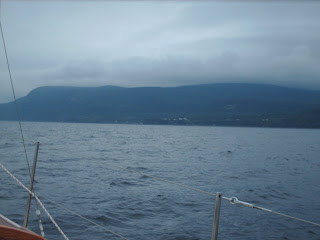The sailing directional route from Rimouski around the Gaspe Peninsula to the small community of Anse-a -Beaufils is a distance of 210 nautical miles and is called the Gaspésie. From Riviere-du-Loup to Cap Gaspe the estuary grows ever wider and the north shore of the St. Lawrence River gradually disappeared from our view. The actual entrance to the Gulf of St. Lawrence is recorded to be at Cap des Rosier near Gaspe but as we sailed toward it we could sense its presence ever approaching. It’s a vast inland sea with water conditions depicting those typical of ocean navigation.
The most northern extent of the Appalachian Mountains rise out of the Gaspe Peninsula, stretch as far south as the state of Alabama and are clearly visible along the route. Their beauty and magnificence is impressive especially seen from the waters of the St. Lawrence and the Gulf. The shore is lined by steep cliffs indented with numerous bays and coves sporting small villages tucked tightly into their far reaches. We noticed how the skyline changed in areas where the villages are located because of the deeply cut valleys of the mountains. The scenery here is spectacular - we were able to see the rolling mountains tops far beyond the shore through the valley cuts. The population along this route wanes and is sparse in some places but those people we met who reside here have wonderful attitudes. They work in the region’s resource based economies and seem to accept the short summer season and harsh winters easily.
There is a phenomenon called the Katabatic Winds that occurs in some of these valleys. We noticed it at Ste. Anne des Monts while we were there. The katabatic wind is a land breeze that funnels down a valley and out its mouth which only occurs at night. The depth and breadth of the valley determines the violent reaction of the winds. They can easily reach a speed of 25 knots as the breeze swoops down from the tops of the rolling mountains. These winds coupled with the force of the southerly winds that pick up speed in the valley corridors make for a heavy turbulence on the waters at the coast. Because the steep rocky coastal cliffs and Appalachian highlands form a barrier for the winds they are caused to veer off and pick up more speed. So these katabatic winds are a force to be respected and reckoned with. We made sure our lines were held securely to our berth for the night.
Another force to be reckoned with is that of the currents. The river tidal currents weakened by the time we reached Rimouski as we had been advised they would. However, there is a current which flows eastwardly called the Gaspe Current. It funnels the water s of both the rugged Saguenay River that empties into the St. Lawrence on the northern shore and those of the St. Lawrence itself all the way to Cap Gaspe. The current’s path is 10 – 20 klms wide and the flow is tremendously strong. As it courses its way through the surrounding water it loses no strength nor does it experience any reversal with the tidal rise.
Another change we noticed was in the temperature of the water. When Keith dove under the boat in the shallow waters of the Longueuil harbour to repair the sounder the water temperature there was 32*C. As our boat is steel hulled we can notice the water temperature even though she is heavily insulated. The waters here are much colder. The colder waters from the north Atlantic flow down from the Labrador coast and through the gap between Newfoundland and Cape Breton Island into the Gulf and estuary by way of the Laurentian Channel. The Laurentian Channel in the seabed is 300 – 400 meters deep depending on the area. The low water temperatures, I am told, are caused by the upwelliings of the colder water of the north shore and those at the beginning of this channel. These waters flow around the large island land mass of Anticosti Island which is perched right in the middle of the estuary. It is no wonder that these waters are often confused and angry and dangerous with so many elements affecting them at any given time. One is wise to be keenly aware of these effects when sailing here and it the right conditions the voyage can offer an utterly exceptional emotional awareness, one I find very difficult to describe.
While travelling this route, I have once again been fortunate enough to experience for a third time in my life, such a powerful upwelling of my own that I was overcome with an emotion that I cannot explain. The first time I felt this wonder was in northern BC when I was quite young. Keith and I were heading north along desolate and remote highways of the BC interior. The quiet awe and majesty of the Rockies seemed to engulf me with such immense power that I felt suspended, minute but not insignificant, almost as an observer invading the big picture of the wonder of our planet. The second time I noticed this overwhelming occurrence burrowing its channel into the depths of my heart and memory was during the birth of both our children and I immediately recognized that I had been positioned in time by that same force before. Now, once again, out here, sailing along the shores of the mighty St. Lawrence River with the captain, quiet and alone amidst the power of the sea and all those that live within it and the natural beauty of the Appalachian Mountains, almost reaching over the river with arm like cliffs and valleys, barren in places, lush in others, radiating its own splendour, in the warm southeasterly breeze, I recognized that same force. There are no words to explain this feeling but I know it to be good; I know it to be clean and I know it to be truly happy.
Transit by sailboat is a leisurely way to reach a destination. One should be of a patient nature, able to accept the pace and if so, the rewards are great. Again, as all sailors know, with this activity there is always a compromise. For us this slower measure offers the gift of pause, a time to reflect, the enjoyment of the natural beauty of our surroundings, and when amassed the impact that they all conjure.







No comments:
Post a Comment